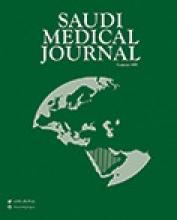Abstract
OBJECTIVE: To evaluate the efficacy, safety, and timing of laparoscopic cholecystectomy in the management of mild to moderate cases of acute biliary pancreatitis.
METHODS: The medical records of 158 patients admitted to Riyadh Medical Complex, Riyadh, Kingdom of Saudi Arabia (KSA) from July 1998 to December 2001 were retrospectively reviewed. Acute biliary pancreatitis was diagnosed in patients who presented with abdominal pain with serum amylase level 3 times the normal limits in the absence of hypercalcemia or hyperlipidemia and presence of gallstones on ultrasonography. Severity of the disease was assessed using Atlanta Symposium criteria. Preoperative endoscopic retrograde cholangiopancreatography (ERCP) was performed in 106 patients (74.6%) on selective basis. One hundred and eighteen patients underwent laparoscopic cholecystectomy after clinical and biochemical resolution of the attack. Standard 4-ports technique was used. Intraoperative and postoperative morbidity and mortality, and postoperative hospital stay were reported.
RESULTS: Laparoscopic cholecystectomy was performed in 118 patients and it was possible in 110 cases (93.2%) after 3-8 days of admission. Preoperative ERCP was performed in 106 patients of mild to moderate acute biliary pancreatitis and common duct stones were retrieved in 19 cases (18%). The procedure was converted to open in 8 cases (6.7%). Postoperative complications were nausea and vomiting in 10, atelectasis in 8, chest infection in 3, and prolonged ileus in 2. The wound complication occurred in 4. One patient who had bile leak due to cystic duct stump avulsion at CBD junction was treated by endoscopic sphincterotomy plus stenting and another patient had partial CBD injury repaired primarily over a T-tube. Mean postoperative hospital stay was 2.4 days. One patient died due to uncontrolled arrhythmia and heart failure.
CONCLUSION: Laparoscopic cholecystectomy can be safely performed for mild to moderate acute biliary pancreatitis after clinical and biochemical resolution of the attack during the same admission with acceptable morbidity and mortality rates. This strategy will lead to reducing the recurring acute biliary pancreatitis, number of admissions and hospital stay.
- Copyright: © Saudi Medical Journal
This is an open-access article distributed under the terms of the Creative Commons Attribution-Noncommercial-Share Alike 3.0 Unported, which permits unrestricted use, distribution, and reproduction in any medium, provided the original work is properly cited.






